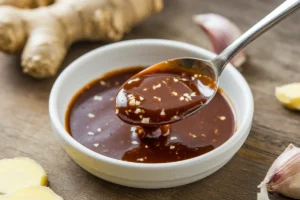What is Miso Glaze Made of?
Miso glaze is a versatile, umami-packed sauce that has become a staple in modern cooking. Known for its savory and sweet balance, this glaze works wonders on various dishes, from fish to vegetables. But have you ever wondered what makes this glaze so special? In this article, we’ll dive deep into miso glaze, explore its ingredients, and give you tips on how to make it at home. Whether you’re a seasoned cook or just starting in the kitchen, you’ll find something valuable here.
Introduction to Miso Glaze
Miso glaze is a flavorful sauce commonly used in Japanese cuisine. In particular, it’s an umami-rich blend made primarily from miso paste, which is a fermented soybean paste. Consequently, this glaze has a sweet and savory profile that complements proteins like fish and meats, and even adds depth to vegetables. A go-to choice for many chefs and home cooks alike, miso glaze is not only easy to make but also extremely versatile.
What is Miso?
Miso is a traditional Japanese ingredient made from fermented soybeans. Typically, it comes in various colors and flavors, depending on the fermentation process. Most notably, white miso (shiro miso) and red miso (aka miso) are the most popular types. Not surprisingly, miso is a key component of many dishes, but it shines especially in the creation of sauces and glazes like the one we’re discussing today.
If you’re curious about the history and origins of miso, you can learn more about the history of miso and its influence on Japanese cuisine. For centuries, miso has been contributing to the signature umami flavor in many Japanese dishes.
The History
The use of miso in cooking dates back to ancient Japan. Over time, it evolved from a simple seasoning to the star ingredient in many sauces and glazes. Today, miso glaze has found its way into Western cuisine, most notably in dishes like miso-glazed salmon, tofu, and vegetables.
The reason for its popularity is the combination of umami, sweetness, and slight acidity that works well with a wide range of foods. For example, miso-glazed fish is a signature dish in many high-end restaurants. Moreover, the glaze’s rich flavor not only enhances the food’s taste but also adds a beautiful sheen, making it visually appealing. As a result, the modern culinary world has embraced for its versatility, allowing it to become a staple in various global cuisines.
Ingredients
So, what exactly is miso glaze made of? While the ingredients can vary depending on the specific recipe, the basic components are consistent. Let’s break them down:
- Miso Paste: The star of the glaze. Generally, miso paste comes in different varieties, but the most commonly used are white miso (milder and sweeter) and red miso (more intense and saltier).
- Soy Sauce: This fermented soy sauce adds a salty, savory depth to the glaze.
- Rice Vinegar: Provides a slight acidity that brightens the overall flavor of the glaze.
- Sweeteners: Usually brown sugar, honey, or maple syrup are added to balance the salty and acidic notes.
- Sesame Oil: Adds a nutty, earthy aroma and flavor, enhancing the depth of the glaze.
- Optional Ingredients: Additionally, some recipes include extras like ginger, garlic, or Sriracha for a bit of heat and extra complexity.
If you’re trying to create your own glaze at home, knowing how to substitute these ingredients can be important. For instance, soy sauce can be substituted with tamari for a gluten-free version, and you can use coconut aminos for a soy-free alternative. By understanding umami flavor, you can also help balance the taste of your glaze, making it richer and more savory.
Ingredient Substitutes
- Soy Sauce Substitutes: If you need a gluten-free alternative, you can opt for tamari. Alternatively, for a soy-free version, use coconut aminos. Both work well in a miso glaze, though tamari is slightly less salty.
- Sweeteners: While brown sugar is common, you can use honey or maple syrup as healthier alternatives.
- Vinegar: If you don’t have rice vinegar on hand, you can use apple cider vinegar or white wine vinegar.
Types of Miso Glaze
Not all miso glazes are created equal. There are a few variations of miso glaze, depending on the type of miso used and whether you prefer a sweeter or more savory profile.
Red vs. White Miso Glaze
- White Miso Glaze: Milder and slightly sweeter, making it perfect for lighter dishes like salmon or tofu.
- Red Miso Glaze: More intense in flavor and saltier, ideal for heartier dishes like.
Sweet vs. Savory Miso Glaze
- Sweet Miso Glaze: Contains more sweeteners like brown sugar or honey, often used for glazing vegetables or sweeter proteins like salmon.
- Savory Miso Glaze: Less sweet and more robust, with extra soy sauce and sesame oil, perfect for meats.
Nutritional Benefits
Miso glaze is not only delicious but also carries some nutritional benefits due to the presence of miso and other fermented ingredients. Here are a few of the nutritional benefits:
- Probiotic Properties: Miso is a fermented product, meaning it contains probiotics that promote gut health.
- Low in Calories: A typical serving of miso glaze is relatively low in calories, making it a great choice for those watching their intake.
- High in Protein: Miso paste contains a decent amount of protein, especially for a condiment.
- Rich in Vitamins and Minerals: Miso is a good source of vitamins B, E, and K as well as essential minerals like zinc, manganese, and copper.
While the glaze does contain some sugar and sodium, it’s still considered a healthier alternative to many store-bought sauces. To maximize its health benefits, you can use alternative sweeteners like maple syrup or honey.
How to Use Miso Glaze
There are many creative ways to incorporate miso glaze into your cooking. Not only does its rich flavor complement both proteins and vegetables, but it’s also a go-to for many home cooks. Below are a few popular uses:
Classic Dishes Using
- Miso-Glazed Salmon: One of the most popular dishes, miso-glazed salmon is a must-try. Ultimately, the sweet and savory glaze pairs perfectly with the richness of salmon.
- Miso-Glazed Cod: Similar to salmon, cod takes well to the glaze’s umami flavors, creating a light and flavorful dish.
- Miso-Glazed Belly: For meat lovers, belly is a match made in heaven.
- Miso-Glazed Tofu and Tempeh: A great vegan or vegetarian option, the glaze adds a burst of flavor to otherwise bland proteins.
Vegetable Pairings
- Stir-Fried Vegetables: Broccoli, carrots, and mushrooms can all be elevated with a drizzle
- Roasted Vegetables: Eggplant, zucchini, and Brussels sprouts all benefit from the savory-sweet balance.
- Salads and Grain Bowls: Use the glaze as a dressing or finishing sauce on top of salads and grain bowls for extra flavor.
How to Make Miso Glaze at Home
Making miso glaze at home is incredibly simple. By following these steps, you’ll have a foolproof recipe:
Basic Recipe:
- 2 tablespoons miso paste (white or red)
- 2 tablespoons soy sauce (or tamari)
- 1 tablespoon rice vinegar
- 1 tablespoon sweetener (brown sugar, honey, or maple syrup)
- 1 teaspoon sesame oil
Instructions:
- First, whisk all ingredients in a small bowl until smooth.
- Then, adjust the flavors to taste (add more sweetness or salt if needed).
- Finally, use immediately, or store in an airtight container in the fridge for up to a month.
Common Mistakes and How to Avoid Them
- Not Whisking Properly: Miso paste can be lumpy, so make sure to whisk it thoroughly to achieve a smooth consistency.
- Overusing Red Miso: Red miso is much saltier and more intense than white miso, so use it sparingly if you prefer a milder flavor.
Storing and Preserving
Miso glaze is easy to store and can last for a while if done correctly. Here’s how:
In the Refrigerator:
- To store, place the miso glaze in an airtight container. It should last for up to a month. Over time, the flavors will deepen, making it even more delicious.
Can You Freeze:
- Yes, you can freeze miso glaze. Simply, place it in a freezer-safe container. To thaw, let it sit in the refrigerator overnight, then whisk to re-incorporate any separated ingredients.
FAQs about
- What is the difference between red and white miso paste?
- Red miso is more intense, saltier, and fermented longer than white miso, which is sweeter and milder.
- Can I use miso glaze as a marinade?
- Yes, miso glaze works wonderfully as a marinade for proteins like fish, chicken, and even tofu.
- Is miso glaze healthy?
- Yes, when used in moderation, provides probiotic benefits and is low in calories.
- What does taste like?
- It has a savory, sweet, and slightly tangy flavor, rich in umami.
- How long does last in the fridge?
- Stored in an airtight container, it can last up to a month.
- What protein pairs best?
- Miso glaze pairs well with salmon, cod, and tofu.
Conclusion
Miso glaze is a versatile and flavorful addition to any kitchen. Whether you’re glazing fish, tofu, or vegetables, this sauce delivers a delicious balance of umami, sweetness, and acidity. In addition, it’s easy to make and store, making it a must-have for home cooks looking to elevate their dishes. Why not try making some at home and taste the difference for yourself?



